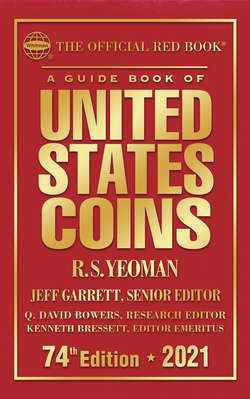Читать книгу A Guide Book of United States Coins 2021 - R.S. Yeoman - Страница 7
THIRD-PARTY GRADING AND AUTHENTICATION
ОглавлениеIn this guide book values from under $1 up to several hundred dollars are for “raw” coins—that is, coins that have not been graded and encapsulated by a professional third-party grading service. Coins valued near or above $500 are assumed to be third-party-graded. A high-value coin that has not been professionally certified as authentic, graded, and encapsulated by an independent firm is apt to be valued lower than the prices indicated.
What is third-party grading? This is a service providing, for a fee, an impartial, independent opinion of a coin’s grade and its authenticity. The grader is neither buyer nor seller, and has no biased interest in the coin’s market value. Third-party grading started in the late 1970s with ANACS (then a service of the American Numismatic Association; now privately owned and operated). ANACS graders would examine a coin and, after determining its authenticity, would assign separate grades to its obverse and reverse (such as MS-63/65) and return it to the sender, along with a certificate and photograph.
In 1986 a group of coin dealers launched the Professional Coin Grading Service (PCGS), which grades coins for a fee and hermetically seals them in plastic holders with interior labels. This “slabbing” helps guarantee that a coin and its grade certificate cannot be separated. In 1987 Numismatic Guaranty Corporation of America (NGC) was started, offering a similar encapsulation service. Both companies guarantee the authenticity and grades of the coins they certify. Coins are judged by consensus, with the graders having no knowledge of who submitted them.
From the 1970s to the present there have been more than 100 different commercial grading companies. Readers are cautioned to investigate the background of a TPG (third-party grader) before trusting in its services.
Today the hobby’s leading third-party grading firms are NGC (Sarasota, Florida) and PCGS (Newport Beach, California).
Professional grading strives to be completely objective, but coins are graded by humans and not computers. This introduces a subjective element of art as opposed to science. A coin’s grade, even if certified by a leading TPG, can be questioned by any collector or dealer—or even by the service that graded it, if resubmitted for a second look. Furthermore, within a given grade, a keen observer will find coins that are low-quality, average, and high-quality for that grade. Such factors as luster, color, strength of strike, and overall eye appeal can make, for example, one MS-65 1891 Morgan dollar more visually attractive than another with the same grade. This gives the smart collector the opportunity to “cherrypick,” or examine multiple slabbed coins and select the highest-quality coin for the desired grade. This process builds a better collection than simply accepting a TPG’s assigned grades, and is summed up in the guidance of “Buy the coin, not the slab.” (Also note that a coin certified as, for example, MS-64 might have greater eye appeal—and therefore be more desirable to a greater number of collectors—than a less attractive coin graded MS-65.)
Over the years, collectors have observed a trend nicknamed “gradeflation”: the reinterpretation, in practice, of the standards applied to a given grade over time. For example, a coin evaluated by a leading TPG in 1992 as MS-64 might be graded today as MS-65 or even MS-66.
The general effect of third-party grading and authentication has been to increase buyers’ and sellers’ comfort levels with the perceived quality of rare coins in the marketplace. And, as mentioned, there still exists the potential for keen-eyed collectors to cherrypick coins that are “exceptional for their grade.”
